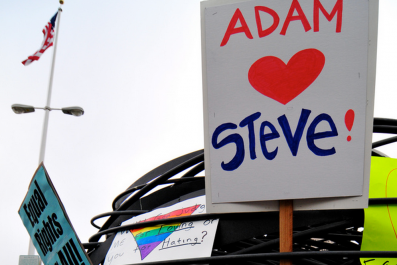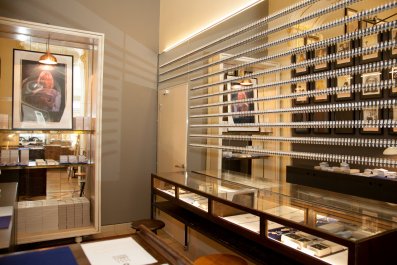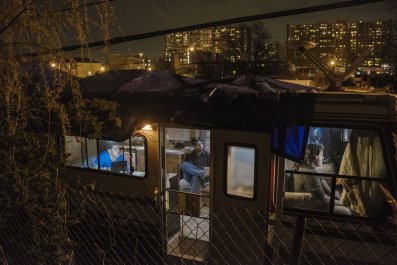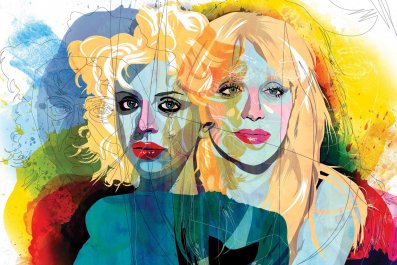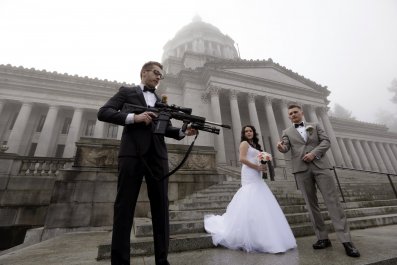A trial lawyer was having a glass of wine with two companions inside the Regency Hotel, on a stretch of Park Avenue that is one of the last preserves of old money in Manhattan. It was February 2006. The bar was called The Library. While sitting there, the lawyer was approached by a radiant blonde who appeared to recognize him. They started flirting. It would be years before they stopped.
The lawyer was John Edwards, the North Carolina litigator turned U.S. senator; he was just beginning his second run for president. The woman was Rielle Hunter, who would become his campaign videographer. As his wife, Elizabeth Edwards fought and lost a battle against metastatic breast cancer, John Edwards and Hunter carried on an affair, eventually conceiving what the press would gleefully brand a "love child."
Given the immolation of Edwards's political career after the affair was made public, you could credibly say his downfall began when he and Hunter locked eyes in The Library. To many, the tryst neatly captured the venality of power, as well as the ancient tension between new lust and trusted love, which has crushed men far more principled than John Edwards.

To me, the affair represented the magic of hotel bars. How romantic to meet someone in a hotel bar, to close the gap of anonymity that modern hotels engender, with their thousands of heads in hundreds of beds, the pervasive whoosh of air conditioners and elevators, the only yearning common to all occupants a decent Wi-Fi connection. I imagine Edwards and Hunter both burnished by the glow of auburn light, warm from the bartender's generous pour, lost in the crowd's happy buzz. You can blame them for a lot, but you shouldn't blame them for that.
If an exculpation is in order, it is for the unimpeachable institution that is the hotel bar. At a good hotel bar, you can never quite be a regular, though you will never be anonymous, always wrapped in the catholic embrace of the hospitality business, perfectly sunny and comfortably impersonal. When left to my own devices, I might well find myself at the Waldorf Astoria's lobby bar, sipping on a manhattan, waiting for Frank Sinatra to slide onto the stool next to mine. It's not that I want to meet someone: In fact, I don't want to meet anyone at all. I want to be neither in the sardine-can crush of a club nor amidst the workaday regulars of the local pub, feigning a Cheers bonhomie. I want the gentle obscurity of a great hotel bar, where I can be just another New Yorker in a sea of Omahans and Parisians.
Related: A Guide to New York City's Top Hotel Bars
There are thousands of places in New York to drink and millions of frazzled New Yorkers to drink in them. There are dive bars (quickly disappearing), as well as wine bars where you can pretend to know the difference between a nebbiolo and sangiovese. There are hipster bars, gay bars, hipster gay bars, sports bars, tiki bars, ironic tiki bars, ironic wine bars, speakeasies, ironic speakeasies, faux speakeasies, Irish pubs, gay Irish pubs and even a few places where you can just have a drink without needing a doctoral degree in cultural studies to fully appreciate the experience.
The hotel bar occupies a special place in this crowded pantheon. A truly democratic institution, it has no natural constituency, nobody to question whether you belong. Because it must potentially make itself available to several hundred guests of disparate origins, cultures and tastes, the bar is unlikely to aspire to the kind of hyperexclusivity fostered by some of New York's finer drinkeries. Because, also, the hotel bar caters to people who do not spend their days monitoring the latest trends out of Brooklyn, they can presumably perfect the tried-and-true, instead of trying to ape the goat milk-and-rum punch of some avant-garde boîte in West Bushwick.
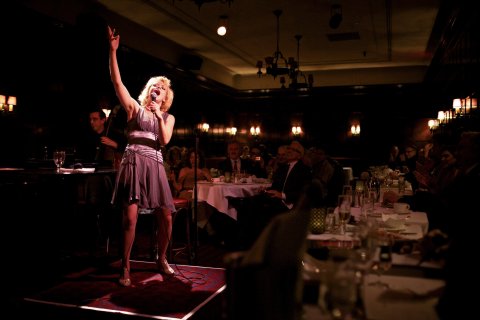
Still, with several hundred hotel bars in New York City, one is assured of nothing and could easily find himself drinking in a sanitized "lounge" full of cosmo-gulping tourists from Palookaville. And were this article to send an unsuspecting explorer from Oslo or Ohio into the frothing, bro-permeated cesspool that is the rooftop of the Gansevoort Hotel, the spilled Fireball on her skirt would be on my hands forever.
Then again, if one chooses carefully, she will discover that a certain type of hotel bar is the finest observation deck in New York City, without the wind gusts, tour groups or selfie sticks.
The kind of hotel bar I have in mind serves its drinks with a chaser of history, art and culture. The kind of place in which I can never afford to stay, except for the length of time it takes to finish a vodka martini (dirty and up, with just one olive). The kind of place where famous people have done infamous things.
These old hotel bars are splendid instead of fabulous, and some would have already been a tad old-fashioned in Don Draper's day. You are just as likely to get tipsy on the history as on the alcohol: Fernand Petiot inventing the bloody mary at the King Cole at the behest of a white Russian who wanted a version of a cocktail he'd once had in Paris; Ludwig Bemelmans painting his Madeline murals at the Carlyle, on the very same walls that had watched Harry Truman and Jackie Kennedy take their libations (not together, of course). These are places where men wear suits, and if the bartenders wear suspenders, they do not wear them ironically, over lumberjack shirts. These are not the places where the Brooklyn kids go. I've been to some of those places. They always leave me craving a proper manhattan.
There are bars that have art in them and bars that are works of art. Few make that second cut: As far as hotel bars in New York go, only the King Cole Bar and Salon at the St. Regis and Bemelmans Bar at the Carlyle truly belong in this rarefied category. These aren't just rooms with paintings or sculptures, but masterpieces in their own right. If you need any more culture with your drink, fill a flask and head to MoMA.
The Carlyle is on a stretch of Madison Avenue crowded with dull, expensive stores. It is named after Thomas Carlyle, the Scottish philosopher who once called human existence "a hall of doom." Well, he clearly never stayed at his namesake hotel, nor had a drink at its signature bar, Bemelmans, which just might be the most effortlessly luxurious space in the city. If this be doom, then damn me for all time.
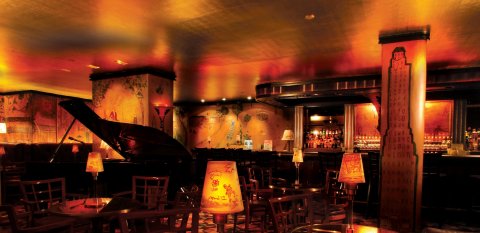
To enter Bemelmans is to step into a children's book, albeit one where you can sip a tom collins. The bar is named after Ludwig Bemelmans, who set loose Madeline on the streets of Paris and in the imaginations of countless children. The walls are covered with his murals, depicting each of the four seasons in Central Park with a loose whimsy that is the hallmark of the Madeline series: a rabbit smoking a cigar, dogs taking tea. Naming the bar one of the best hotel spots in the city, Forbes pointed out that it is "reassuring to know that seeing images of an ice-skating elephant doesn't mean you've been over-served."
This is, to be sure, the Upper East Side of Louis Auchincloss and the Episcopalian ancien régime, where ambition is anathema and the sun is almost always over the yardarm. In the evenings, there is piano music; in the afternoons, soft jazz plays on the stereo, a silken blanket over the room's conversations. The ceiling is gold foil, while the banquets have the color of oxblood; after your second drink, you might well come to feel that you've found yourself in the most whimsically wrapped chocolate bar in the world. After your third, the notion of a big and cruel city somewhere out there will come to seem preposterous. Drinking is, of course, the most adult of occupations, after sex and gardening. Come to think of it, Madeline is now old enough to belly up at Bemelmans herself.
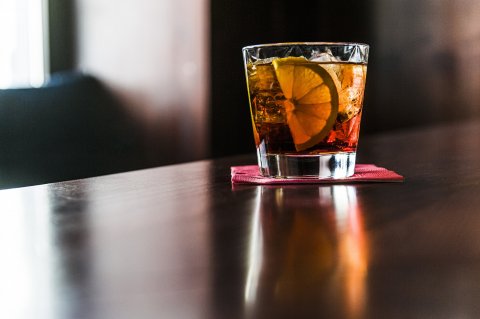
The King Cole at the St. Regis is less a refuge from reality than Bemelmans, but it arguably has the more famous work of art: Maxfield Parrish's 30-foot-long Old King Cole mural, hanging behind the bar and gleaming anew ever since a 2007 restoration that scrubbed the work free of nicotine and grime at a cost of $100,000. That ain't cheap, but the St. Regis presidential suite runs about $22,000 per night. Money has been spent on far worse endeavors.
Parrish painted the mural at the behest of John Jacob Astor IV for $5,000 in 1906, for another hotel. The mural was moved to the St. Regis in 1932. Its original patron, who perished aboard the Titanic, is depicted as the king at the center of the mural, a classic Tuscan landscape behind him. But he is not portrayed with the adulation he might have expected: Some of his courtiers appear to be flummoxed, as you can discern while ordering the red snapper (the bar's name for a bloody mary, allegedly invented here). The cause of their perturbation is Old King Cole's noisomely broken wind, which makes for the famous central joke of the King Cole mural. To drink at the gleaming wooden bar is to drink in the wake of Astor's epic fart. But you're drinking well, in one of the most exalted hotels in New York. Have another. The smell will pass.
Almost every great hotel in New York City is now part of some "collection," which is to say a transnational conglomerate based in Munich or Beijing. History rarely figures into the profit margins, and as the city's great hotels become submerged into vast hospitality chains, they become subject to the relentless corporate forces that won't rest until Manhattan looks exactly like Dubai, down to the Fendi outlets.
When the Waldorf Astoria was sold in the fall of 2014 to a shadowy Chinese concern for $1.95 billion, it became the most expensive hotel in the world. With an investment like that, one surely expects returns, but the new owners, the Anbang Insurance Group, wisely allowed Hilton Worldwide to keep operating the hotel, and the Hiltons have wisely kept things as they are and have pretty much always been.
The Waldorf Astoria may be the most unabashedly regal hotel in the city, a 47-story bastion of art deco magnificence that has housed every president since Herbert Hoover—there's even a secret railroad that FDR used to travel from Grand Central to the Waldorf, to avoid being seen in a wheelchair. The hotel has an archivist and a fairly comprehensive history website where you might find oddities like an image from a Robin Williams photo shoot at the hotel, the actor reading a newspaper while a Mrs. Doubtfire look-alike hangs from a chandelier.
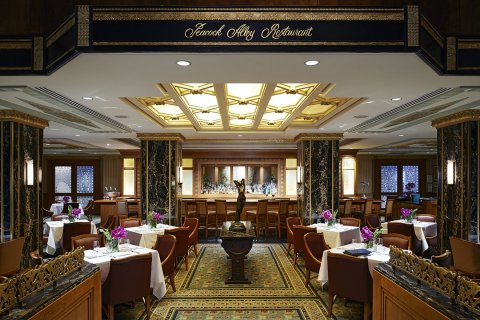
There are many places to drink within the Waldorf Astoria, and they are by no means equal. The hotel's palatial lobby has a restaurant, Peacock Alley, partitioned from the rest of the lobby but not immune to the noise of an endless procession of tourists. On a recent night, as I sat sipping a glass of port, a female pianist filled the room with gorgeous sound. Next to me pulled up a Midwestern-sounding tourist who said something about Instagramming his cocktail.
"It's very important to Instagram things," the bartender said with enough dryness for a proper martini. The Midwesterner, oblivious, continued, wondering how many tales of woe the bartender had heard over the years.
"I've heard more happy than sad," the bartender retorted. Can a place to drink have a finer endorsement?
For an altogether different sensation, traverse the length of the Waldorf Astoria, which spans an entire block of Manhattan, for the dark wood of the Bull and Bear, a reference to the vicissitudes of Wall Street and an acknowledgment of the powering force of capital. The Bull and Bear, which was once known as the Men's Bar, has one of my favorite features: a bar placed at the center of the room, which locates the solitary diner-drinker, as I was that night, in the middle of the action. One does not always want to drink with his back to his fellow man.
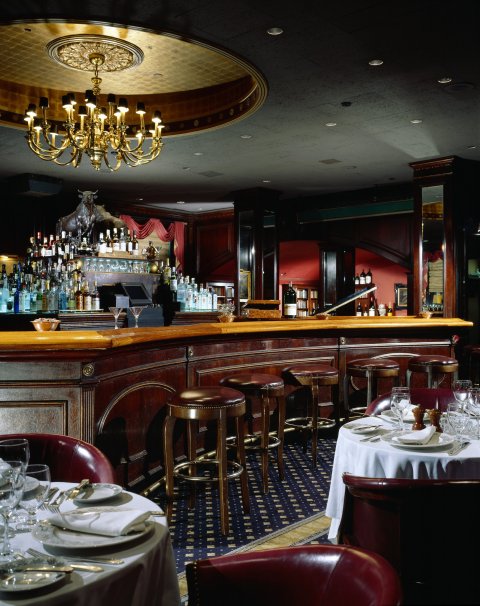
Many bars around the city have tried to re-create what comes to the Bull and Bear so effortlessly. The hamburgers are solid, the cocktails are strong, and the servers are solicitous without ever lapsing into obsequity. There are surely more original places to drink in the city, but there are evenings, too, that call for wood and leather and uncomplicated arrangements of spirits. Rising from the center of the bar is a statue of the two animals for whom it is named. You are drinking in a temple to mammon. Tip generously.
The Hotel Algonquin is located just outside of the arrhythmic heart of Times Square, which has had more cosmetic surgery than a Hollywood C-lister eager for reality-TV glory. There was a time when the Algonquin needed no introduction, though it needs just a little today. From 1919 until 1929, it was the gathering place of the Vicious Circle, a group of wits and wags that included, most famously, the writer Dorothy Parker, playwright George Kaufman and New Yorker editor Harold Ross. But the good times didn't last; the Algonquin fell into the same decrepitude as the surrounding neighborhood, beginning its climb back only in the late aughts, after a renovation of many millions of dollars.
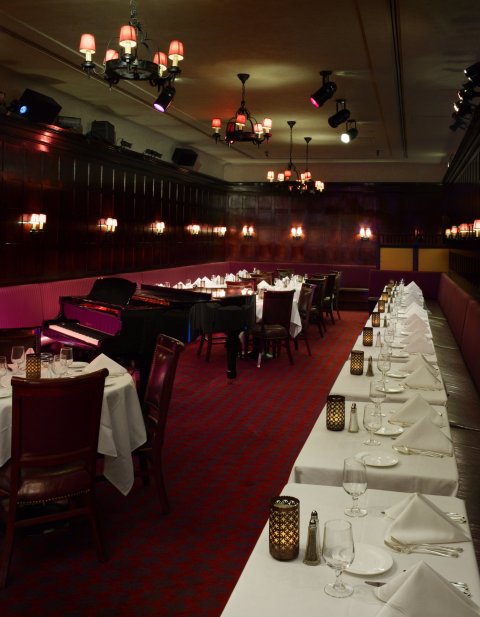
In its attempts to appeal to moneyed tourists who might otherwise stay at the W, the Algonquin decided, among other efforts, to shutter its own Oak Room, "one of New York's most loved cabaret spaces," as NPR deemed it, once home to crooners like Diana Krall and Harry Connick Jr. Despite a petition signed by thousands, the Oak Room closed in 2012, converted into what The New York Times called "a lounge as part of a rewards program for loyal guests." Loyal Manhattanites would have to find somewhere else to go.
The hotel's current social spaces suffer from a personality disorder, unsure of how thoroughly to allude to the past or reflect present tastes. The lobby rests in an easy old-fashioned comfort, recalling the early 20th century without falling down an ersatz rabbit hole. It is, in its own right, a fine place to sit for a drink or a meal, though lobbies being what they are, one forfeits all pretenses to privacy or, should one seek it, silence. (The Round Table restaurant is toward the back of that lobby.)
The hotel's main drinking establishment, the Blue Bar, is illuminated by blue LEDs that glow from the walls and are embedded in the bar itself, making the whole place feel like a fishbowl. It is not a welcome sensation. The wood-paneled walls, the leather banquets and the drawings by Al Hirschfeld, that great chronicler of Broadway, would make the place far more comfortable, if they weren't always obscured in a bluish darkness. Instead, all you can see are the blue lights and the two televisions that hang threateningly behind the bar. As the Times noted, "A drink can be a touch less enjoyable with a commercial for Passages Malibu Addiction Center as a backdrop." Ms. Parker would have surely had something to say about that.
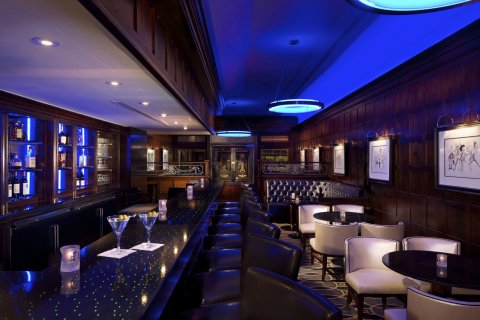
The Jane Hotel has had an easier time than the Algonquin in climbing back from oblivion. Whether it has climbed somewhere desirable is a slightly more complicated question. The hotel stands at the southern edge of the Meatpacking District, whose face-lift has been dramatic and grotesque. This was once a place where animal meat was sold by day and human flesh by night. Today, those streets are traversed by tourists from Paris and Shanghai, hands full of shopping bags from Apple and doggie bags from Spice Market.
An old hotel for sailors that once housed Titanic survivors, the Jane Hotel precedes all that, harking back to the days when this was a working waterfront, when the only Italians here were dockworkers recently arrived from Palermo. It is a Victorian fortress with a single hexagonal tower at the joint of its two flanks, standing watch over the West Side Highway, presumably guarding against an invasion by New Jersey (too late, some say).
The Jane feels like much of the rest of Greenwich Village: restored almost to the point of kitsch. It would be a feat to write about the hotel without invoking Wes Anderson, so closely is it aligned with his quirky sensibility: palm fronds, wood paneling, stuffed animals, stuffed chairs, chandeliers. It is lavish, but also a little twee, somehow less than entirely grown-up, like many of Anderson's protagonists. You might take a younger sibling here; you probably wouldn't take an older one.
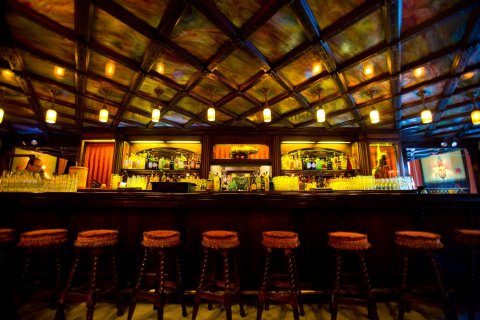
Whether you actually manage to get into the Jane Ballroom, which looks like a count's mansion in the South of France, is another matter. It is two floors of plush, red-carpeted magnificence where celebrities are known to spend their late nights: The bar has been called one of the foremost places in the city to spot those blessed with fame, so I guess if your idea of a good time is trying to Instagram the Olsen twins doing Champagne Jell-O shots, do show up on a Saturday midnight.
I showed up on a Friday afternoon, to find the Jane Ballroom almost entirely empty, gloriously so, as if the usual starry occupants had fled, leaving us mortals to cavort at will. I found myself drawn to the Jane's front bar, far less luxurious but far more cozy than the ballroom into which it opens, a grotto of dark wood and warm light. A colleague and I spent a good hour talking about fatherhood, utterly uninterrupted. Scenesters humping velvet ropes, bouncers keeping the bridge-and-tunnel crowd at bay, DJs blasting the latest from Justin Bieber or Rihanna: This may be the Jane most people know, but it doesn't have to be that way. Come early, don't stay late, and don't spread the secret too far.
But not every place needs a renovation, an update, a reimagined cocktail menu. Which brings me to the Roger Smith, whose dusty facade looks to have had preciously few cleanings since the days Travis Bickle wandered these streets, complaining about Manhattan's filth and decay. The vertical neon marquee that faces Lexington Avenue looks like an ancient appendage, a vestige in luminous green. The brick itself is of indeterminate color.
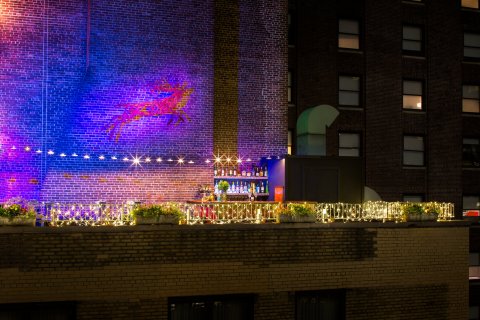
But as with all great hotels, maybe all great buildings, the door of the Roger Smith is really just a cleverly concealed time machine. In this case, your trip is back to late-1980s Manhattan, a city of cheap rents and cheaper thrills, a place at once more serious and less uptight than the Manhattan of today. Since 1987, the hotel has been owned independently by James Knowles, a Yale- and Penn-educated sculptor who inherited the place from his father-in-law. His own sculptures occupy seemingly every inch of free space in the hotel, including the sidewalk outside, where one of two cylindrical works that stand like sentries on the stoop hides a charging station for Knowles's electric car. I was shown around the hotel by its art director, Danika Druttman, a young British woman who takes her job as seriously as any gallery curator in West Chelsea. She explained that Knowles's solution has always been to add instead of renovating, and the result is a kind of wonderful clutter, a rejoinder to all things sleek and neutered.
Lily's, the ground floor bar at the Roger Smith, is small, and you could easily miss it. I hope you don't. The large windows offer a panorama of Lexington Avenue, where workers endlessly hurry to and fro; you can sit there reading faces for hours. The walls are a lush cranberry red, painted in places with garish designs, while the bar is decorated with a multicolored collage. The whole thing gives the impression that Jean-Michel Basquiat had a run of the place for one delicious afternoon.
The bar is sparse, almost comically so. But there is something refreshing about that. Do I really need to choose from 17 small-batch bourbons every time I order a manhattan? Am a I philistine for sometimes craving a Yuengling? In a Manhattan more moneyed by the year, Lily's harks back to a city still dirty and dangerous enough for artists to make their way here. And it subtly complicates our narrative of progress, our assurances to ourselves that, by every measurable metric, the city of 2015 is infinitely superior to the city of 1985. Sitting at Lily's with a bottle of domestic beer, I am not so sure.
Don't bother telling me what I have left out on this tour, for I know that I have left out plenty. Setting aside my historical preferences, I could mention the Breslin at the Ace Hotel and the Library at the NoMad, classy newish joints that cater to a younger, less fusty crowd that knows a thing about artisanal bitters and heritage breeds of pork. There's the beer garden at The Standard, the rooftop at the Wythe in Brooklyn (yes, there are now hotels in Brooklyn), and so many others that deserve mention. One could spend his or her life moving from New York hotel to New York hotel: a tryst with a Norwegian, a drink with a Nebraskan. Someone would need to fund the profligate enterprise. Isn't that why they have Kickstarter?
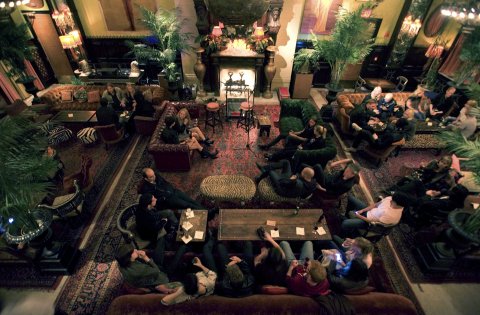
But my favorite hotel-related spot in Manhattan is, in fact, not in a hotel at all. It is at the end of a subway platform in Times Square, a plain white door, above which is artfully engraved a single word: "Knickerbocker." There is no explanation, though one gets the sense that this is far more than just some obsolete subway signage.
In fact, the door used to lead to the Knickerbocker Hotel, built in 1906 by John Jacob Astor IV and the original home to Parrish's famous mural now ensconced at the St. Regis. The door led to a passage "furnished with settees and decorated with heraldic banners," which in turn led into one of the city's most sumptuous prewar hotels. Later, the building became the offices Newsweek, making for what were surely the magazine's most comfortable quarters (not that I begrudge my current cubicle in lower Manhattan). Later yet, the hotel fell into disrepair, like so much of the rest of the city. The passageway was sealed against the desperate souls who sought a variety of nefarious pleasures in the city's underground, if not a place to simply sleep.
Recently, the Knickerbocker opened once again. The renovation reportedly cost $240 million, but if tourists open their wallets for $300-per-night rooms, the investors should be just fine. The new Knick, calling itself a "luxury lifestyle hotel," has a restaurant by the well-known chef Charlie Palmer, while the breakfast caddy features a USB charging port, according to the hotel's website. Your battery full, you won't miss a single tweet.
The Knickerbocker passage is still closed, though perhaps not forever, for we lovers of New York history are more numerous than developers and politicians usually suppose. For now, the Knick can be proud of the best new work of hotel art in the city, a sumptuous black-and-white mini-mural by the Queens-born artist and writer Molly Crabapple, which stands at the entrance to the Knick's rooftop bar, high above the endlessly roiling pit of Times Square. Boschian in its richness, the mural chronicles choice moments from the history of the Knickerbocker: the trade of Babe Ruth from the Red Sox to the Yankees, the regular gatherings of Tammany Hall machers and crooks, the drunken antics of Zelda and F. Scott Fitzgerald, the arrival in 1908 of Oliver Fritchle, who made the trek from Nebraska in an electric car. How refreshing it must have been, for intrepid Oliver, to pull up at the Knick and emerge from the monthlong journey, knowing that a drink awaited him inside.



